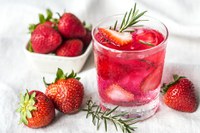Prairie Fare: Enjoy Lounging Outdoors With a Refreshing Beverage
(Click an image below to view a high-resolution image that can be downloaded)
By Julie Garden-Robinson, Food and Nutrition Specialist
NDSU Extension
“Wait. Stop the van,” I said to my husband.
He knew what I saw and pulled to the side of the street.
“We can fix them!” I said with enthusiasm.
He sighed rather heavily.
Yes, he’s usually the fixer and I am the painter.
Actually, sometimes I just decide where to put things.
I had just spotted two more Adirondack chairs, bringing my total to six in various states of disrepair this year. All the chairs needed was a little tightening of the screws and a fresh coat of paint.
I guess we like to save or preserve things, including furniture.
I began my furniture-saving trend last year. I have two sunny yellow Adirondack chairs in my backyard from last year’s curbside finds. My chairs offer an inviting space to enjoy snacks on our patio.
Moving dining outdoors is a fun way to enjoy beautiful summer weather.
A couple of years ago, I asked one of North Dakota State University’s interior design faculty members, Ann Ragan, to write an article for our “Eat Smart. Play Hard. Together” magazine. I will share some of Ann’s tips below as you create an outdoor living and dining space.
- Provide a variety of furniture to create an inclusive space capable of accommodating a variety of users. Include seating that is sturdy, has a seat height of 17 to 20 inches, and has a full back and arms to assist individuals who may have difficulty rising from a seated position.
- Offer flexible seating when the number or size of people using the space varies. Providing benches with one continuous cushion allows for people to sit anywhere on the bench without the discomfort often associated with sitting where two cushions meet.
- Remember that lounge furniture can take up a large amount of space, but it provides the most comfortable reclining positions and often is equipped with cushions. The depth of a seat can affect comfort. If a chair is too deep, properly sized back pillows with firmer filler can improve comfort.
- Consider whether your space is protected from the weather, which will determine what types of furniture, materials and fabrics are best to use. Consider water/hail resistance when selecting furniture. Metal furniture is durable and less likely to be damaged, tip over or blow away during a strong storm.
- Carefully consider the color of the paint used on the metal because this often can impact how warm the material will get on a hot, sunny day. Lighter colors reflect more of the light from the sun, which helps keep the metal cooler to the touch.
- Consider how the furniture fits into the space. Because wood is a natural material, wood furniture blends seamlessly into the natural elements of an outdoor environment. Some wood furniture may need to be stained and sealed properly to protect the wood and reduce fading or discoloration from exposure to the sun and weather.
- Consider a variety of plastics, including recycled plastic furniture. One of the biggest challenges with plastic outdoor furniture is connected to weight. A piece of furniture that is too light has the potential to tip over or blow away during a storm.
Now that you have a comfortable spot to sit, be sure to slather on sunscreen (at least SPF 30), and stay hydrated and nourished with plenty of colorful fruits and vegetables.
As you lounge, consider making some snacks and perhaps some infused water to sip in the summer heat. Remember that perishable food, including cut fruits and vegetables and various dips, should spend no more than one hour outside on a 90-degree day.
This week, instead of a typical recipe, I am providing several tips to make “flavored water” safely at home.
If plain water is kind of boring, try infusing the water with fruit and/or herbs. Be creative and invent some new flavor sensations.
Start with clean hands, containers, cutting boards and knives. Rinse fruit and herbs thoroughly.
Try one of these flavor add-ins:
- Citrus water: 1/2 cup sliced oranges, lemons or grapefruit plus 2 quarts water
- Strawberry kiwi water: three sliced strawberries plus one peeled, sliced kiwi plus 2 quarts water
- Watermelon rosemary water: 2 cups seedless water melon (cut in chunks or balls) plus one sprig rosemary plus 2 quarts water
- Raspberry lime water: 20 crushed raspberries plus two sliced limes (without rind) plus 2 quarts water
Refrigerate overnight.
Don’t mix batches. Use up the batch, clean the container and make a new batch.
(Julie Garden-Robinson, Ph.D., R.D., L.R.D., is a North Dakota State University Extension food and nutrition specialist and professor in the Department of Health, Nutrition and Exercise Sciences. Follow her on Twitter @jgardenrobinson)
NDSU Agriculture Communication - June 13, 2019
| Source: | Julie Garden-Robinson, 701-231-7187, julie.garden-robinson@ndsu.edu |
|---|---|
| Editor: | Ellen Crawford, 701-231-5391, ellen.crawford@ndsu.edu |



